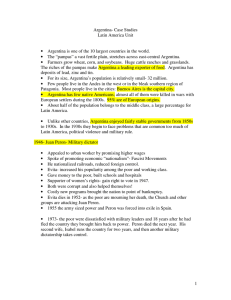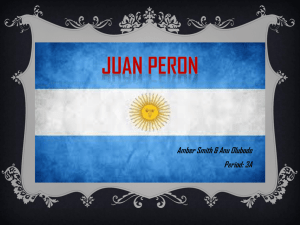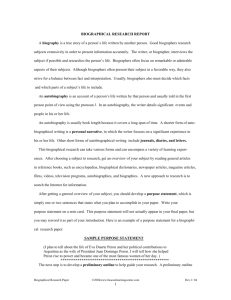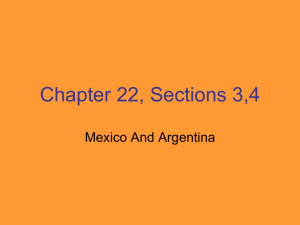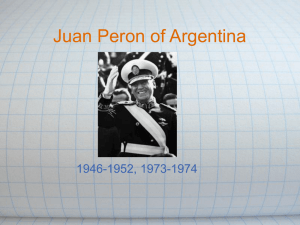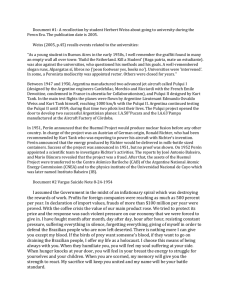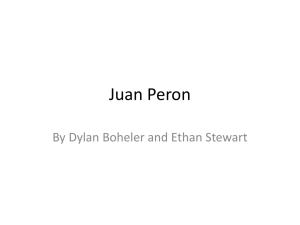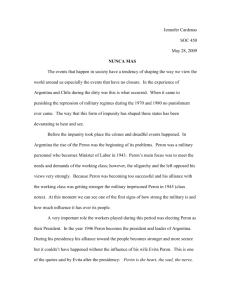AIM: WHAT WAS ARGENTINA LIKE UNDER THE LEADERSHIP OF JUAN PERON’S
advertisement
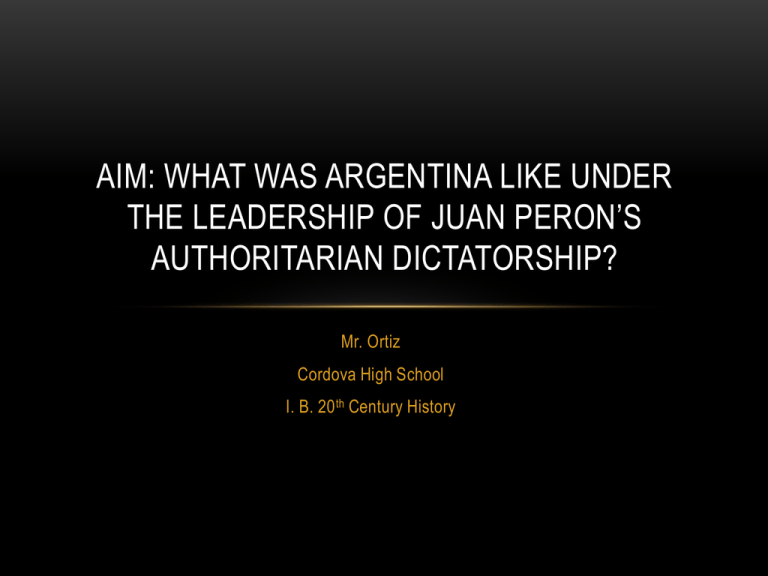
AIM: WHAT WAS ARGENTINA LIKE UNDER THE LEADERSHIP OF JUAN PERON’S AUTHORITARIAN DICTATORSHIP? Mr. Ortiz Cordova High School I. B. 20 th Century History ARGENTINA AND WWII ● From 1932 until 1943 Argentina was ruled by a coalition of parties called the Concordancia. ● Argentina was the only country in the Americas that did not contribute to the Allied war effort. ● It appeared that President Castillo would manipulate the 1943 election so that Robustiano Patron Costas would win. ● Nationalists believed that Costas would end Argentina’s neutrality and have the country enter the war against the Axis Powers. ● A military coup overthrew the Castillo regime on June 6, 1943. ● General Pedro Ramirez became president. ● 1943 US placed new financial and trade restrictions on Argentina and pressured other Latin American countries to do the same. ● US increased its military aid to Brazil and Argentina was afraid Brazil would attack. ● Ramirez agreed to break diplomatic relations with the Axis by the end of January 1944. ● Nationalists in the government forced Ramirez to resign and Vice President General Edelmiro Farrell became president ● With the overthrow of Ramirez, Peron became Argentina’s Vice President and Minister of War. ● Farrell scheduled a national election for February 1946. ● Peron established the Partido Laborista (Labor Party) and began to campaign for the presidency. ● Peron won by 300,000 votes out of the 2.7 million cast (54%). THE LEADER • Juan Domingo Peron (18951974) • Born in Buenos Aires to a lower-middle class family • Joined the military at the age of 16 • Juan stayed in Italy from 1938-1940 to study the fascist regime • He believed that neither liberal democracy or totalitarianism were viable options • He married Eva Duerte (Evita) in 1945 • Argentinian workers were Peron’s main power base HTTPS://WWW.YOUTUBE.COM/WATCH?V=ZU0P04 Z2YZQ • His goals were to achieve social justice and economic independence for Argentina • Peron was anti-clerical • He sympathized with the Nazis and provided safety for many of them after World War Two, however he was not anti-Semitic • In 1947 Peron disbanded the Labor Party and replaced it with the Sole Party of the National Revolution. • Women received the vote in 1947 and Peron had Congress pass legislation that increased women’s access to education and improved their wages and working conditions. THE ELIMINATION OF OPPOSITION AND RULE OF THE REGIME • Peron participated in the military coup that overthrew the conservative president, Ramon Castillo • The police force was used to oppress Peron’s liberal opponents • Peron had complete control of Argentina’s armed forces • In opposition areas he restricted civil liberties • In 1949 Peron changed the Constitution so that he could be re-elected • He denounced any opposition as traitors • Peron avoided allying with either the socialist of capitalist cause • The US initially opposed Peron, claiming that he had fascist ties • Peron took power just after World War Two ended, and remained in power for much of the Cold War • Peron’s policies mirrored his belief that another world war was going to break out ● Peron’s economic program was initially successful and in July 1947 Argentina paid off its entire foreign debt. ● From 1949 onward Peron’s programs were less successful. • To raise money to fund the creation of new industries, the government created the Instituto Argentino de Promocion del Intercambio (Argentine Institute for the Promotion of Trade) or IAPI. THE ELIMINATION OF OPPOSITION AND RULE OF THE REGIME CONT… • Peron bought out most Argentinian newspapers in order to weaken his opponents • Wages were increased for laborers • Extensive railroads were built in the country to help “nationalize” it • Thousands of hospitals and schools were built under his regime • Evita was used effectively for propaganda; her popularity along with her radio talk show helped raise support for Peron’s government ● Juan was elected to his first term as president in 1946 ● Eva was now the first lady, the most powerful woman in Argentina ● The rich had a hard time accepting her, as evidenced by the Charitable Society, a women’s organization, denying Eva the honorary position of President ● Eva retaliated against this by cutting of the society’s federal funding and starting her own foundation, The Eva Peron Foundation ⦿Eva’s foundation helped the poor get jobs, food, clothing, money, and anything else they could want ⦿There are no financial records for the foundation, so it is not known how much money was taken in and how much was kept ⦿The people adored Eva for what she did for them,a and considered her a saint • Peron’s relationship with the United States reflected the ideas of his political party the Peronist. • He dislike the United States involvement in world affairs and their involvement in war trade. • United States did not support the Peronist party because they were based on European fascist and communism. • Peron did not agree on many of the same issues as the United States, • so this put a major boundary between the two countries. • Peron stated this “We are not anit-American, but we do not desire to march to the beat of foreign drums”. • This statement not only talks about the United States, he also refers to the rest of the world. • Peron wanted to have a self sufficient country, so this affected his image at home and the rest of the world. • This helped Peron become president for the second time in Argentina ⦿In 1951, Juan decided to run again for President ⦿Eva wanted to run with him as Vice President ⦿When she accepted the nomination, she made it look like she was bowing to the people’s will , but it didn’t work ⦿The military told Peron that they would try revolution if Eva didn’t renounce her candidacy ⦿Juan told Eva to step down and, though crushed, she did as she was instructed ● Shortly after her renunciation, Eva began feeling ill ● She was diagnosed with Uterine Cancer, the same disease that had killed her predecessor, Aurelia ● She had a hysterectomy, but it wasn’t enough to stop the cancer ● She voted in the election from a hospital bed and, though seriously ill, attended the inauguration ● She got through the ceremonies with a triple dose of pain-killer before and a double dose after ● Shortly after the inauguration, Eva died at the age of 33. EVA PERON PERON’S FALL FROM POWER ● Except for a short recovery during the Korean War, after 1949 Argentina entered a period of severe recession which included several drought-induced bad harvests. ● The 1948 Marshall Plan gave loans and credits to Western European countries that could be used only in the US and Canada. ● Exports dropped so low that in 1952 Argentina actually had to import wheat. ● Real wages dropped 20% from 1949 to 1952 as inflation reached 30 % per annum. ● The amount of money in circulation increased from 6 to 45 billion pesos during Peron’s two terms. ● Starting in 1951, the regime grew more repressive. ● In 1953 Peron gave Standard Oil the rights for exploration, drilling, refining, and distribution in Argentina and this was the last straw for the nationalist military. ● After Eva died, Juan planned on having her embalmed, so she would last forever ● Dr. Pedro Ara was asked to do the job, and he did it beautifully ● A tomb for Eva was in the works, but Peron was ousted before it could be completed ● When Eva died, Peron lost his link to the people, and this hurt him greatly ● September 1955 military overthrows Peron. ● After his overthrow, Peron fled the country • After the military coup, Peron went into exile in Paraguay. • His escape was facilitated by his friend, President Alfredo Stroessner of Paraguay • who placed a gunboat at his disposal on the River Plate. • Later he lived in Panama, where he met nightclub bolero singer María Estela Martínez. • Eventually settling in Madrid, he married her there in 1961. She became better known as Isabel. • Back in Argentina, Peronism was still banned and active Peronists were sometimes persecuted. • In the 1950s and 1960s Argentina was marked by frequent coups d'états. • It experienced low economic growth in the 1950s but rebounded with some of the world's highest growth rates in the 1960s. • The nation also faced problems of continued social unrest and labor strikes. • Yet during those years poverty almost disappeared, with poverty rates between two percent and five percent in the first years of the 1960s . • General Alejandro Lanusse took power in March 1971 and had declared his intention to restore constitutional democracy by 1973. • The way was thus open for Peron's return. • From exile Peron supported centrists such as Radical Party leader Ricardo Balbín, as well as Catholic-left-wing Peronists, and proPeronist labor unions • On March 11, 1973, general elections were held. • Peron was banned from running, but a stand-in candidate, Héctor Cámpora, was elected and took office on May 25. ● On June 20, 1973 Juan and Isabel returned to Argentina ● On July 13, President Hector Campora resigned to make way for Peron ● Peron shocked the nation when he announced that he and Isabel would run together on August 4 ● Isabel accepted the nomination, and the Peron’s won the election, thus giving Isabel the office that had been denied to Evita, the Vice-Presidency ● Isabel, however, was thrust into the spotlight when Peron died on July 1, 1974 of bronchial pneumonia JUAN PERON ● Perón died on July 1, 1974, recommending that his wife, Isabel, rely on Balbín for support. ● At the president's burial Balbín uttered a historic phrase, "This old adversary bids farewell to a friend." ● Isabel Perón succeeded her husband to the presidency ● but proved thoroughly incapable of managing the country's mounting political and economic problems the violent left-wing insurgency and the reaction of the extreme right. ● Ignoring her late husband's advice, Isabel granted Balbín no role in her new government, instead granting broad powers to López Rega. ⦿Isabel took over the presidency when Juan died, and promised to adhear to his policies strictly ⦿Problems beset her presidency from the start ⦿Inflation rose and political struggle continued between the Peronists ⦿What the army feared would happen if a female became president happened with Isabel ⦿In 1976, Isabel was ousted in a coup, thus ending the Peron regime, and a great chapter in Argentine history
